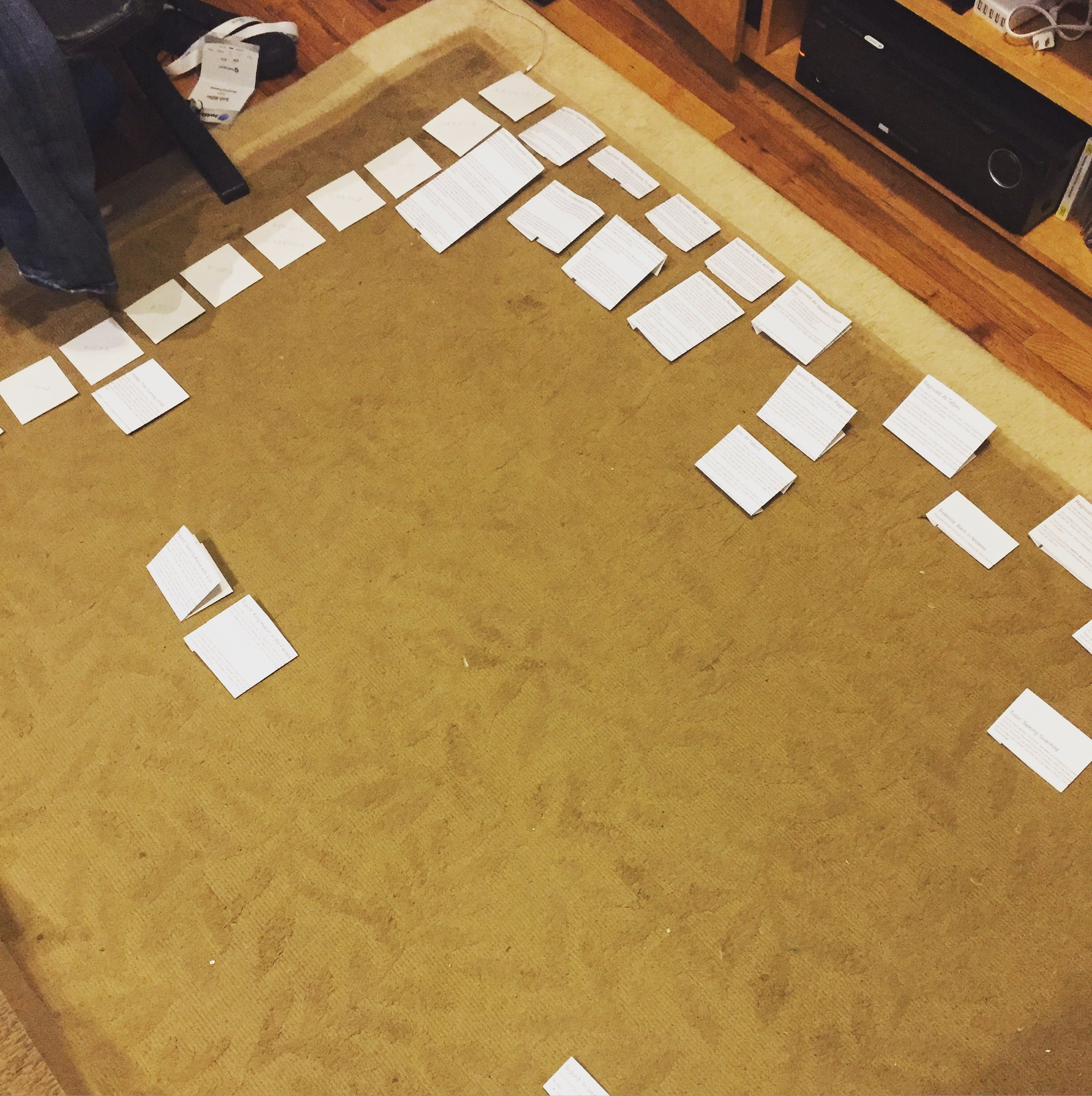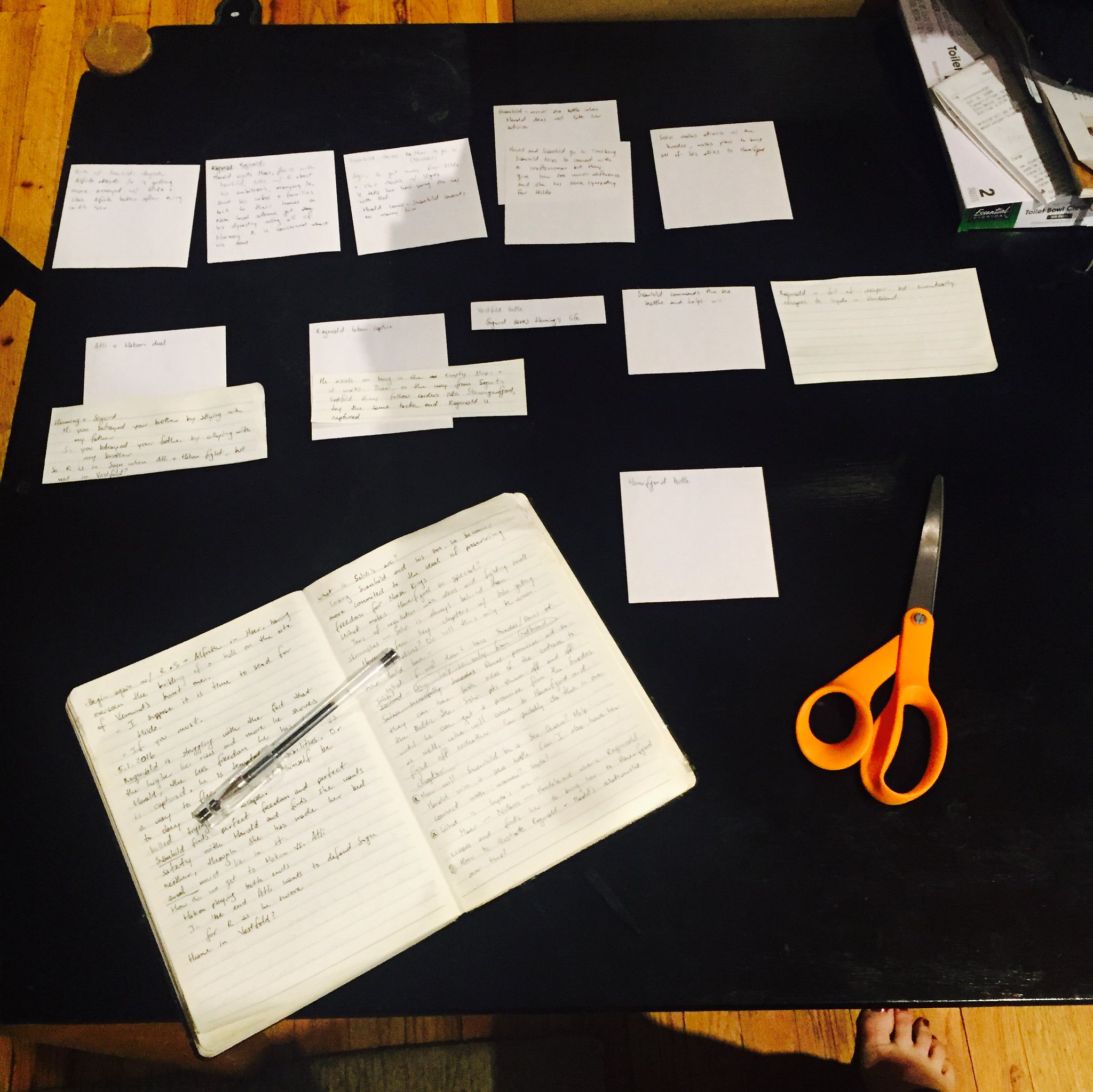
There are a huge number of books and even more blog posts about the process of writing a novel, and processes that you can use to write your novel, and they are all very helpful even when they contradict each other, and they all have the potential to be deeply unhelpful as well.
I don’t think I learned any of the below in my MFA program–that was helpful for other things, but was more focused on writing as art than as craft, and the work of planning and outlining, I think, is largely in the craft arena. I learned what I know by going through several NaNoWriMos, by reading Chuck Wendig and Film Crit Hulk, as well as too many other writing books to name, and by trying things, and when they stopped working, trying something else.
Mixed metaphor alert! Writing a novel is somewhere between turning a block of marble into a sculpture and untangling a giant snarl of many threads into a beautiful tapestry. Sometimes you’re chiseling away, sometimes you’re breaking things, sometimes you’re untangling, and sometimes you’re weaving. And that’s just the rough draft. In the next draft, the scissors and the hammer come out and it all starts again.
When I am writing a rough draft, I have four guiding principles:
- Begin with the end in mind.
- Try to write 2000 words every day making forward motion, and never fewer than 500.
- Do not go back and edit earlier chapters. If you have ideas for how they should change, write them down as notes, pretend you already did them, and go forward.
- Try to end each writing day with an idea of what to write the next day
In order to accomplish that when writing THE SEA QUEEN, the sequel to THE HALF-DROWNED KING, I started with a high level idea of where I wanted each of the next two books to end, the major historical events that needed to occur, and the major plot beats other than historical events that my characters needed to go through. I expanded this into a table that described of what was going on with my main characters through both of the next two books. This was 8 pages long, and pretty high level.
I copied the beats and their descriptions from that document into the note card view of Scrivener. (Scrivener is the application I use to write. It has some planning functions, like the ability to look at all the chapters or scenes as note cards, and it makes it very easy to rearrange things.)
Then I got writing. Occasionally I ran into snags, and went to my longhand journal to write about the problems until I had a solution. I often came up with new subplots that needed to be added back into earlier chapters, so I started a chapter summary, that listed all the chapters with a description of what happens in them and a to do list of things I need to add to them in the next draft. And I changed my mind from the original outline, and made notes about what had changed.
It’s been going pretty smoothly so far. I’ve been writing quickly, which is easy to do with good planning, and years of research behind it. But I’ve written about 85,000 words now on THE SEA QUEEN and I’ve run out of the stuff I had planned relatively thoroughly, and gotten into murkier territory, so it was time to do some serious planning. My philosophy about planning and outlining is:
- Don’t do much more than is necessary to get moving again.
- The use of planning and outlining is in that moment. The act of planning is the important thing, not as much the plan that comes out of it which will always change. I will play with the outline, and have new ideas, and re-outline at least into the third draft.
I think the problem that a lot of writers have with outlining is that it feels like a straitjacket, like all of the fun of discovery has gone out of the process. To bring in yet another metaphor, I view the outline or any planning document as a map for a hike in unfamiliar woods. It doesn’t mean you can’t wander, poke into things, follow a stream for a while instead of the path, but it tells you what is there broadly, and where you want to go.
So Sunday I decided that I needed to know what all my major characters were up to at all moments in the plot. I wrote out all of my characters’ names and arranged them vertically on the floor. Then I printed out my chapter summaries and arranged them horizontally. This is when it really became clear that aside from the ending and a few major beats, I really have no idea what’s happening in the back half of the novel.
I started working on a few story lines, sketching them out in a notebook, but the mess on the floor looked untenable–this was going to take more than an afternoon, and the apartment is too small for many bits of paper on the floor to be undisturbed for longer than that. So that’s when when I started looking for outlining software. And after testing and discarding 5 different timeline/post-it tools, I discovered Aeon Timeline which integrates with Scrivener, and lets you assign an Arc, Characters, and Places to each timeline event, then view the timeline by those things. So I’ll be able to see what all my characters are up to at any given time.

Sunday and Monday I spent time writing out story problems longhand in my notebook, and then translating them into timeline elements, which I then checked to make sure everyone is in the right place at the right time. I have any number of characters who all need to be present at the final battle (or dead by then, in which case their deaths need to have the right drama, witnesses, fallout), and each of whom need to get to the final battle for their own reasons and following their own paths. Which, in a novel with many characters doing many different things at cross purposes all over Norway, is challenging enough.
However, the biggest challenge is figuring out what needs to happen to put my characters through beats that are entertaining to a reader, important to their growth, and illustrative of the novel’s themes. That work is not done on the floor, or in the right software, but in thinking and writing, and making sure I really understand my characters, who they are, and how to push them. This is all logistics. The fun, and far more challenging part, is making sure that everything that happens feels organic to the characters, surprising, and yet inevitable. Hopefully this planning will help get me there.